Preschool Disability Video Modules
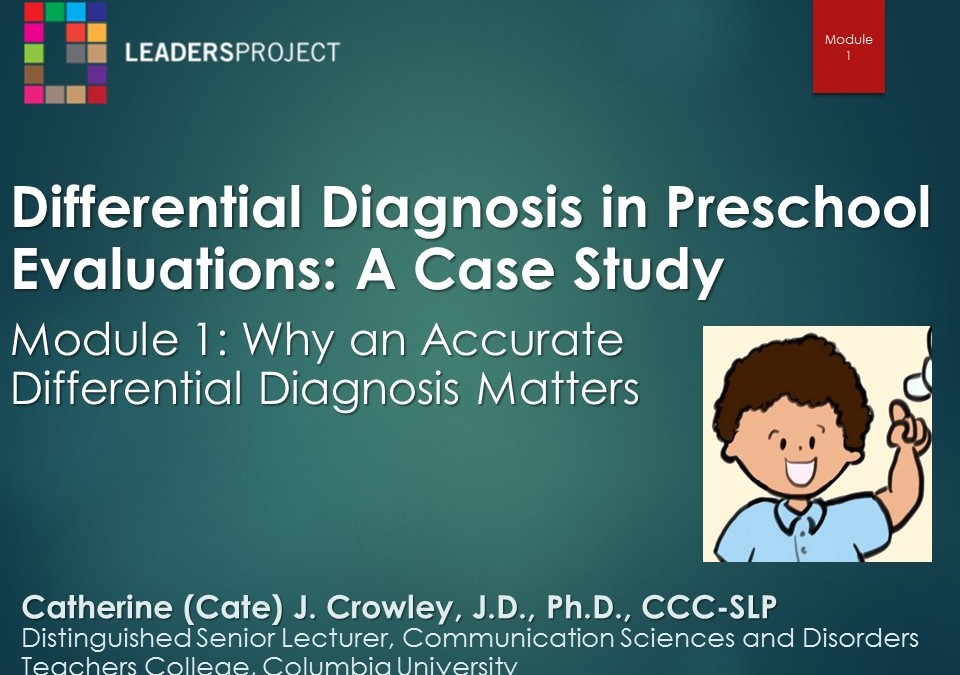
Differential Diagnosis in Preschool Evaluations: A Case Study (DDPE Playlist)
Dr. Cate Crowley walks us through an appropriate evaluation of a culturally and linguistically diverse (CLD) preschooler, previously misdiagnosed. She takes us from the parent interview, to interacting with the child, writing the evaluation and even formulating appropriate IEP goals.

Why an Accurate Differential Diagnosis Matters (DDPE Playlist: Module 1)
In this module, Cate introduces the DDPE module series by discussing why it is so important to get an accurate diagnosis. She does so by demonstrating a real-life evaluation step by step.
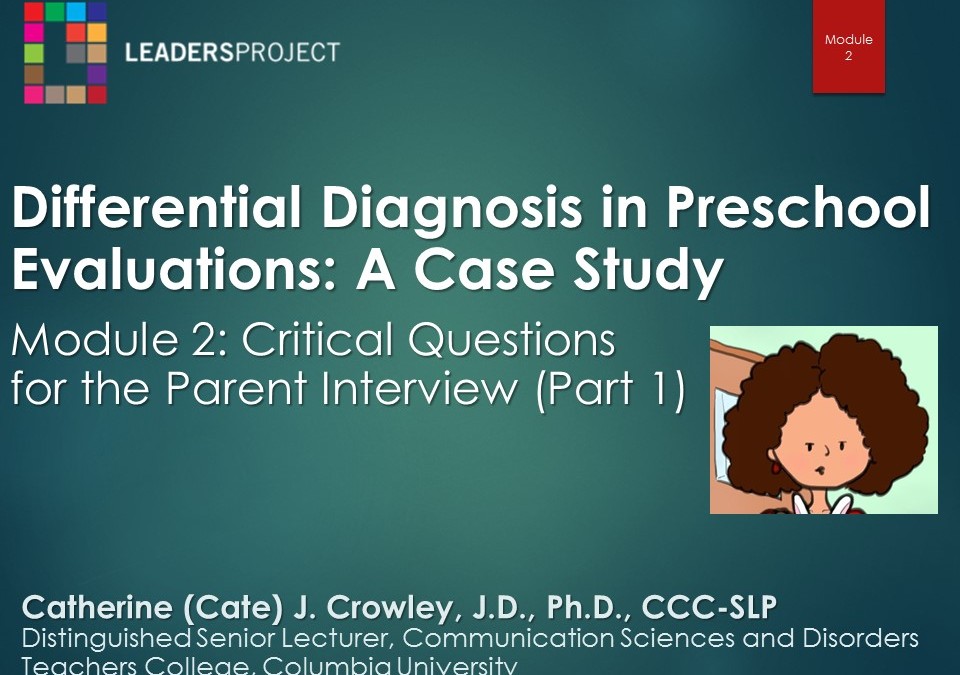
Critical Questions for the Parent Interview Part 1 (DDPE Playlist: Module 2)
In this second module, Cate reviews the critical questions that should be asked of the parent during an evaluation and begins the first part of the interview with Alex’s mother.
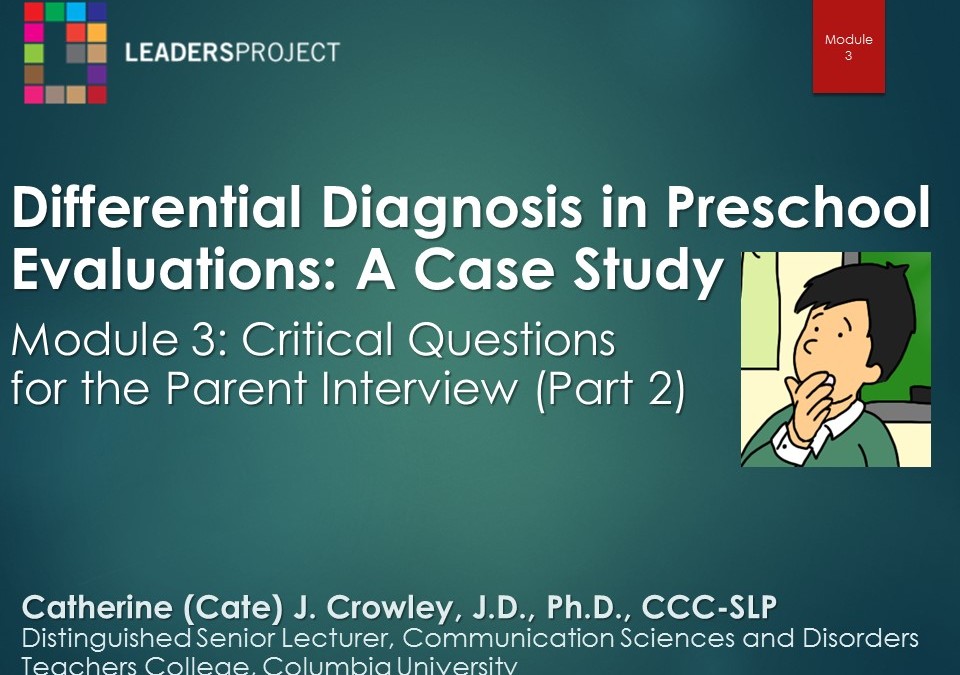
Critical Questions for the Parent Interview Part 2 (DDPE Playlist: Module 3)
In this third video module, Cate continues on with the critical questions that need to be answered during the parent interview.

Academic Language in Receptive and Expressive Language (DDPE Playlist: Module 4)
In this video module, Cate introduces the child being evaluated for this case study and begins the evaluation by using a variety of materials available on LEADERSproject.org.
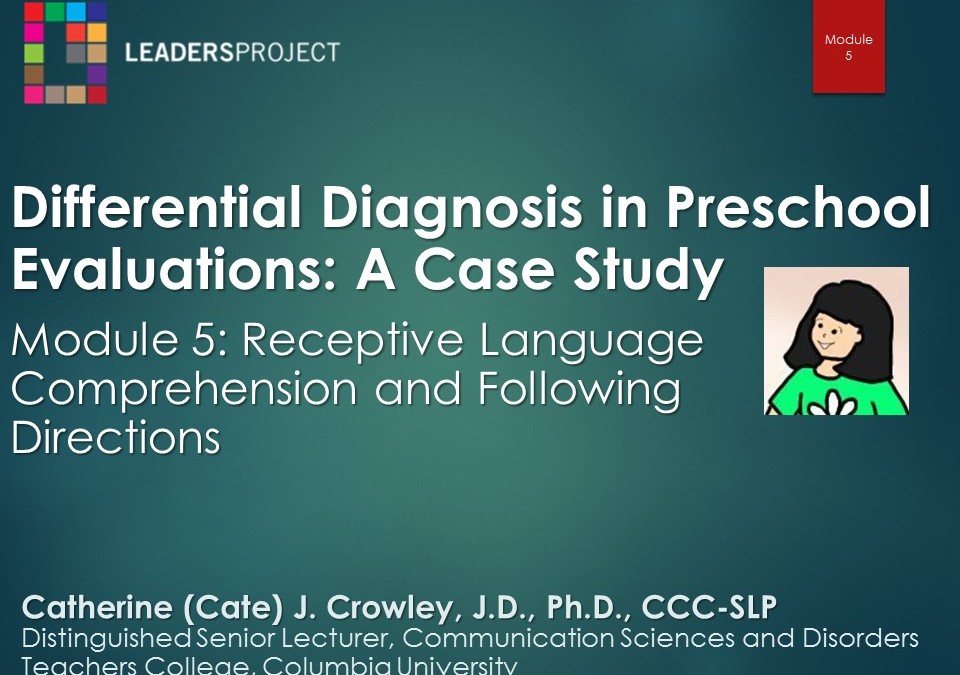
Receptive Language Comprehension and Following Directions (DDPE Playlist: Module 5)
In this video module Cate continues to look at the child’s receptive language skills using excerpts of auditory comprehension subtests from the PLS-5 English and Spanish editions.
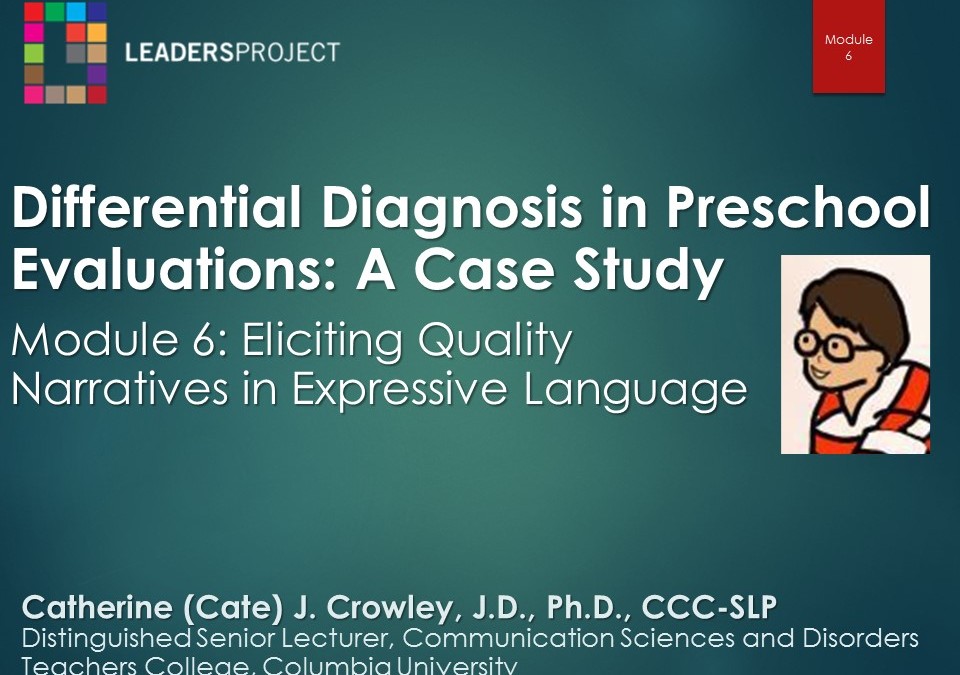
Eliciting Quality Narratives in Expressive Language (DDPE Playlist: Module 6)
In this module Cate shows us how to elicit a quality narrative sample in order to assess expressive language.
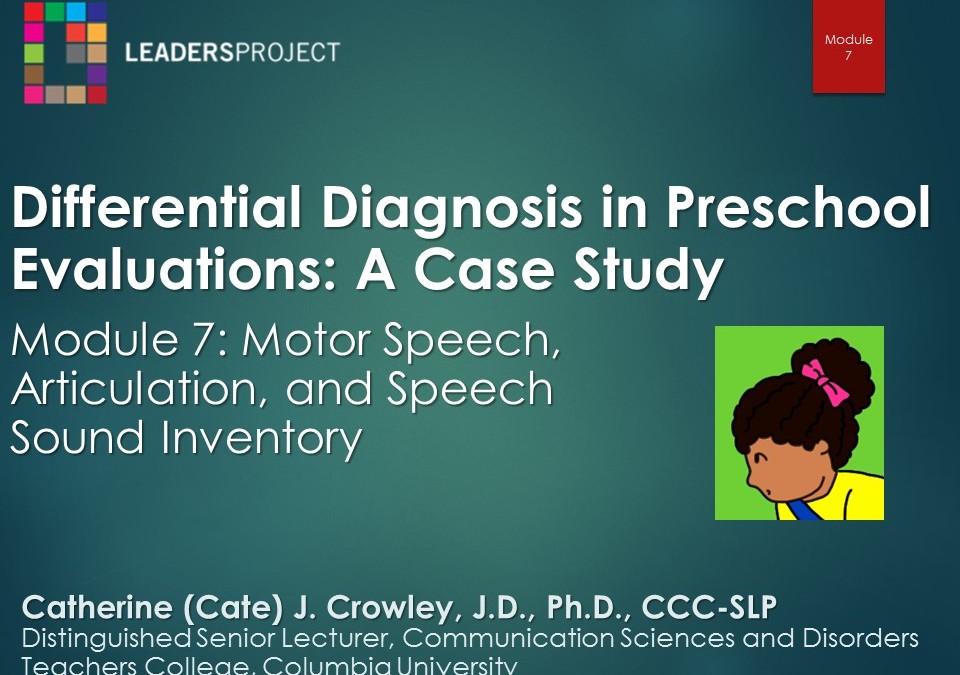
Motor Speech, Articulation, and Speech Sound Inventory (DDPE Playlist: Module 7)
In this module, Cate continues with the evaluation by performing an assessment of Alex’s speech and articulation through the use of an articulation screener from the PLS-5.
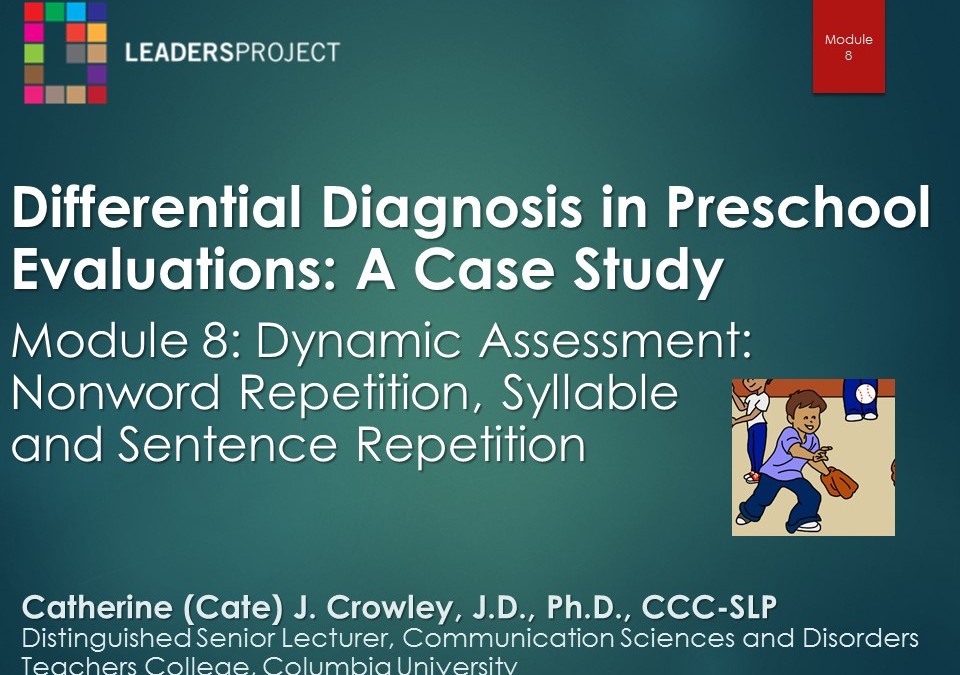
Dynamic Assessment: Nonword Repetition, Syllable and Sentence Repetition (DDPE Playlist: Module 8)
In this module Cate discusses using dynamic assessment using repetition of nonwords, sentences and syllables (Dollaghan & Campbell, 1998) to help confirm Alex’s diagnosis of developmental apraxia.
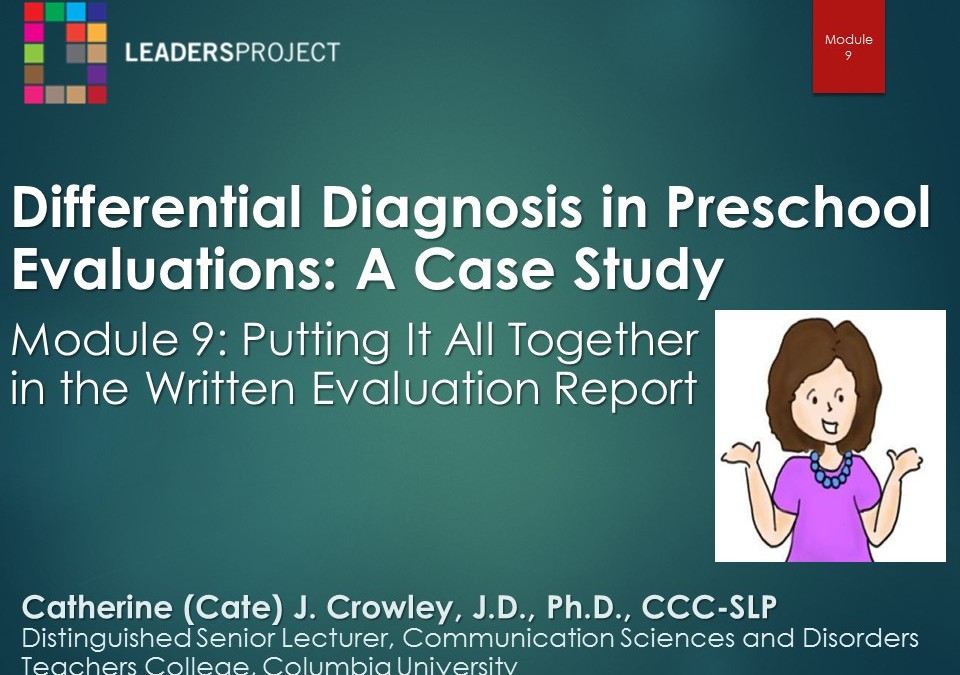
Putting It All Together in the Written Evaluation Report (DDPE Playlist: Module 9)
This module reviews how Cate combines all the information gathered during the assessment and puts it together into a diagnosis and final report.
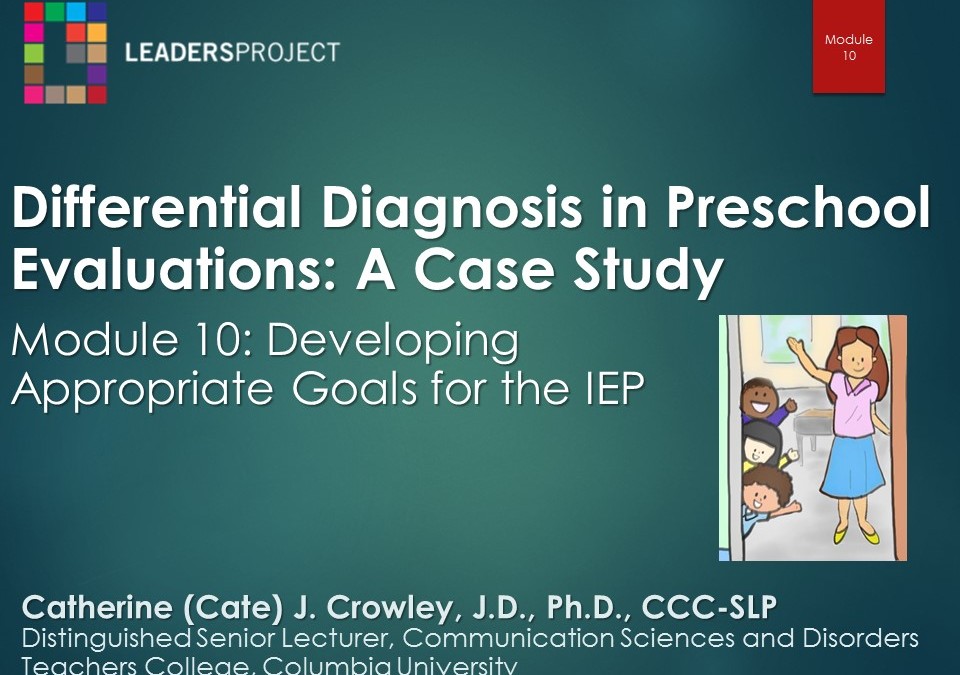
Developing Appropriate Goals for the IEP (DDPE Playlist: Module 10)
In this module, Cate reviews the conclusions of the evaluation and works to develop goals that will provide the support that Alex really needs.
Preschool Disability Evaluations (PDE Playlist)
This is a collection of 38 modules from Cate Crowley’s NYCDOE workshop regarding preschool children and accurate disability evaluations.
Introduction to Preschool Evaluations (PDE: Module 01)
This module introduces the module series on appropriate disability evaluations for culturally and linguistically diverse preschoolers.
Problems with Traditional Assessment Procedures (PDE: Module 02)
This module discusses how traditional assessment procedures (i.e. standardized test scores) used for determining disability are problematic.
NYCDOE and NYSED Policy Regarding Preschool Disability Evaluations (PDE: Module 03)
This module reviews what the law says regarding disability evaluations of preschoolers, especially for those preschoolers who are culturally and linguistically diverse.
Test Scores and Disproportionate Referrals (PDE: Module 04)
In this module, Cate discusses the consequences of using test scores to determine disability.
Introduction to Psychometric Data (PDE: Module 05)
This module introduces the psychometric characteristics used to judge the validity of assessments that are used in determining disabilities.
Validity Part 1- Construct Validity (PDE: Module 06)
In this module, Cate discusses the validity of standardized tests and whether they measure what they claim to measure.
Validity Part 2- Validity, SES, and the WISC-IV Spanish (PDE: Module 07)
In this module, Cate discusses the bias found in the WISC-4 Spanish. Using the normal curve, she plots the mean score of 2 groups- Group A: children from low SES backgrounds and Group B: children from high SES backgrounds.
Validity Part 3- ELLs, IQs, and Cognitive Tests (PDE: Module 08)
This module examines validity issues for psychological tests such as the lack of validity of standardized IQ tests when used with bilingual individuals and English language learners (ELL).
Reliability (PDE: Module 09)
In this module, Cate explains two types of reliability (test-retest and inter-examiner) in terms of standardized tests.
Standard Error of Measurement and Confidence Intervals (PDE: Module 10)
This module examines the role of standard error of measurement in standardized language and psycho-educational tests.
Introduction to Appropriate Assessment Procedures (PDE: Module 11)
In this module, Cate introduces how to appropriately assess preschoolers for disabilities without the use of test scores.
Socioeconomic, Linguistic and Cultural Bias in Testing and Labeling Tasks (PDE: Module 12)
This module examines different sources of bias that are present in commonly used standardized language tests.
Appropriate Assessment Procedures- Part 2 (PDE: Module 13)
This module examines different sources of bias that are present in commonly used standardized language tests.
Appropriate Assessment Procedures- Part 3 (PDE: Module 14)
This module discusses how to do preschool evaluations in an accurate and appropriate manner.
The Goal of Appropriate Preschool Disability Evaluation (PDE: Module 15)
This module introduces the module series on appropriate disability evaluations for culturally and linguistically diverse preschoolers.
Normal Second Language Acquisition (PDE: Module 16)
In this module, Cate discusses the two types of bilinguals: simultaneous and sequential.
Factors Influencing Bilingual Development (PDE: Module 17)
This module investigates factors that influence bilingual language development.
Why is the Parent Interview so Important? (PDE: Module 18)
This module discusses how the parent interview is the best tool for identification of language impaired children, not just from middle class families, but also from Spanish speaking families.
Critical Questions 1-4 (PDE: Module 19)
This module is the first of three presenting the critical questions: nine essential questions that must be asked in every caregiver interview during an evaluation.
Critical Questions 5 & 6 (PDE: Module 20)
This module presents the next two of nine critical questions that must be asked during the caregiver interview.
Critical Questions 7-9 (PDE: Module 21)
This module presents the last three of the nine critical questions.
Holograms Part 1 (PDE: Module 22)
This module discusses the necessary data and information that must be in every evaluation so that the administrator can feel comfortable giving the child an IEP or not.
Holograms Part 2 (PDE: Module 23)
This module sets the standard for a competent evaluation. Cate presents how to incorporate examples from the evaluation and parent interview into holograms in order to produce a quality evaluation.
Andrea Language Analysis (PDE: Module 24)
This module analyzes examples of linguistic structure present in Andrea’s narrative about Cinderella.
Andrea Critical Questions (PDE: Module 25)
This module applies the critical questions to Andrea’s narrative about Cinderella.
Shift in Clinical Practice (PDE: Module 26)
This module explains the need to shift the clinical practice from the traditional score driven method of evaluating children for disabilities to one supported by holograms and appropriate assessment.
How do we Know a Disability Exists? (PDE: Module 27)
This module explains that the administrator must be able to “see” that the child has a disability, based on the data and examples included in the evaluation.
Dynamic Assessment: Cognitive Assessment (PDE: Module 28)
This module explains what dynamic assessment is through an example for viewers.
Dynamic Assessment: Non-Word Repetition Task Part 1 (PDE: Module 29)
This module demonstrates dynamic assessment using the non-word repetition task with a typically developing child and a low-average performing child.
Dynamic Assessment: Non-word Repetition Task Part 2 (PDE: Module 30)
This module demonstrates dynamic assessment using the non-word repetition task with a child with a mild language delay and a child with a moderate to severe delay.
Dynamic Assessment: Fast Mapping Introduction and Example 1 (PDE: Module 31)
This module introduces another form of dynamic assessment: fast mapping.
Dynamic Assessment: Fast Mapping Introduction and Example 2 (PDE: Module 32)
This module includes a different example of fast-mapping with a child with a mild delay.
Dynamic Assessment: Fast Mapping Introduction and Example 3 (PDE: Module 33)
This module provides another example of dynamic assessment using fast-mapping with a child with a mild to moderate delay.
Language Sample: Subway Photo (PDE: Module 34)
In this module, Cate demonstrates one of her tried and true dynamic assessment tools, the Subway Photo from her SLAM Card Series.
Clinical Judgment/Informed Clinical Opinion Part 1 (PDE: Module 35)
This module begins to explain exactly what clinical judgment, or informed clinical opinion, is and how to use it during the evaluation process.
Clinical Judgment/Informed Clinical Opinion Part 2 (PDE: Module 36)
This module further describes where clinical judgment comes from: Linguistic and cultural informants (e.g. teachers, parents, people from the speech community).
Quantification without Standardized Tests (PDE: Module 37)
This modules explains how to provide quantification for a delay or disorder, if one exists, as it is required by the law.
Conclusion (PDE: Module 38)
Now that viewers have completed the video module series and learned about the bias and psychometric flaws inherent in standardized tests, Cate asks evaluators to change the clinical practice.

![[feed link]](/wp-content/plugins/rss-just-better/rss-cube.gif)